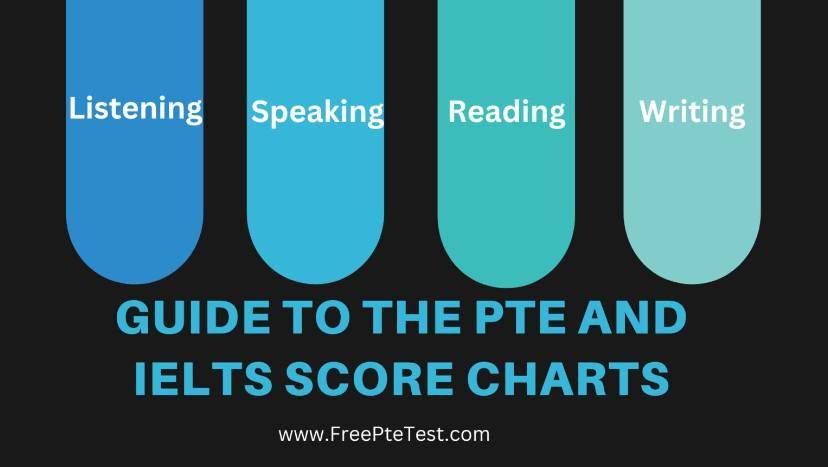Comparision of PTE and IELTS Score Charts: In the journey of studying or working abroad, English proficiency tests play a pivotal role. Among the most widely recognized assessments are the Pearson Test of English (PTE) and the International English Language Testing System (IELTS). These tests serve as gatekeepers for opportunities such as academic admissions, employment, and migration. Understanding their score charts is essential for achieving your desired outcomes.
PTE Score Chart
The PTE Academic exam evaluates your English language skills in four key areas: Speaking, Writing, Reading, and Listening. Each section is scored independently on a scale ranging from 10 to 90 points. The overall score, known as the PTE Academic Score, is also reported on this scale.
- Speaking Section: This section assesses your ability to effectively communicate in English. Fluency, pronunciation, and content are crucial. Typically, scores are expressed in points, with increments of 1 from 10 to 90.
- Writing Section: In this segment, your ability to convey ideas coherently and accurately in written English is evaluated. Tasks include summarizing written text and essay writing. The score is tallied in 1-point increments from 10 to 90.
- Reading Section: This part measures your reading comprehension skills. You’ll encounter various question formats, such as multiple-choice, fill-in-the-blank, and reorder paragraphs. The score is tallied in 1-point increments from 10 to 90.
- Listening Section: This section assesses your ability to comprehend spoken English in academic and everyday contexts. Tasks include summarizing spoken text, multiple-choice questions, and fill-in-the-blank exercises. The score is tallied in 1-point increments from 10 to 90.
PTE Academic Scores
– Communicative Skills Scores: These scores reflect your proficiency in Speaking, Writing, Listening, and Reading. They provide insights into your ability to communicate effectively in English.
– Enabling Skills Scores: These scores indicate your performance in grammar, oral fluency, pronunciation, spelling, vocabulary, and written discourse. They offer detailed feedback on specific language competencies.
– Overall Score: The overall PTE Academic Score is derived from your performance across all sections. Institutions and organizations often have minimum score requirements for admission or employment.
IELTS Score Chart
The IELTS exam assesses your English language skills through four modules: Listening, Reading, Writing, and Speaking. Scores are reported on a scale from 0 to 9, known as the IELTS Band Score.
- Listening Module: This module assesses your comprehension of spoken English in a variety of settings. Scores are reported in whole and half bands, ranging from 0 to 9.
- Reading Module: In this segment, your reading comprehension skills are tested through a range of texts. Scores are reported on a scale from 0 to 9, in whole and half bands.
- Writing Module: This section assesses your ability to articulate ideas effectively in written English. Tasks include essay writing and report summarization. Scores range from 0 to 9, in whole and half bands.
- Speaking Module: In the Speaking test, your ability to communicate verbally in English is evaluated through a structured interview. Scores range from 0 to 9, in whole and half bands.
IELTS Band Scores
– Band 9: Expert User: Fully operational command of the language with complete fluency and accuracy.
– Band 8: Very Good User: Very good command with occasional inaccuracies and misunderstandings.
– Band 7: Good User: Good operational command with occasional inaccuracies and inappropriate usage.
– Band 6: Competent User: Effective command but with some inaccuracies and misunderstandings.
– Band 5: Modest User: Partial command with frequent inaccuracies and misunderstandings.
– Band 4: Limited User: Limited command with frequent breakdowns in communication.
– Band 3: Extremely Limited User: In highly familiar situations, conveys and understands only general meanings.
– Band 2: Intermittent User: No real communication possible except for the most basic information using isolated words or short formulae in familiar situations.
– Band 1: Non-User: Essentially has no ability to use the language beyond a few isolated words.
– Band 0: Did Not Attempt the test: Did not answer the questions.
Choosing Between PTE and IELTS
Both PTE and IELTS have their unique advantages and formats.
– Test Format: PTE is entirely computer-based, while IELTS includes face-to-face speaking interviews.
– Scoring System: PTE uses a point-based scoring system, while IELTS utilizes a band score system.
– Test Availability: PTE offers more frequent test dates and faster score reporting compared to IELTS.
– Test Content: Both tests cover similar language skills but may differ slightly in question types and formats.
Conclusion
Understanding the score charts of PTE and IELTS is crucial for achieving your desired outcomes in education, career, or migration. Whether you opt for PTE or IELTS, thorough preparation and familiarity with the test format are essential. By deciphering these score charts and choosing the test that aligns with your strengths and preferences, you can embark on your journey towards English language proficiency and success.
For more information, click here: https://www.pearsonpte.com/research/scoring
FAQs on PTE and IELTS Score Charts:
Q1. What is the difference between the scoring systems of PTE and IELTS?
PTE uses a point-based scoring system ranging from 10 to 90 for each section and the overall score. IELTS, on the other hand, employs a band score system ranging from 0 to 9 for each module.
Q2. How are the scores for PTE and IELTS calculated?
PTE scores are calculated based on automated scoring algorithms for the Speaking and Writing sections, while human raters evaluate the Speaking and Writing sections in IELTS. Scores for both tests are determined by performance against predetermined criteria.
Q3. What is the validity period of PTE and IELTS scores?
PTE scores are typically valid for up to two years from the date of the test, while IELTS scores are generally valid for up to two years as well. However, it’s essential to check with the specific institution or organization regarding their score validity requirements.
Q4. How long does it take to receive PTE and IELTS scores after taking the test?
PTE scores are usually available within five business days after the test date, while IELTS scores are typically available online after 13 calendar days.
Q5. Can you retake the PTE or IELTS test if you’re not satisfied with your scores?
Yes, both PTE and IELTS allow test takers to retake the exam if they are not satisfied with their scores. However, there may be limitations on how soon you can retake the test, so it’s advisable to check with the testing center or organization.
Q6. Do universities and institutions have minimum score requirements for PTE and IELTS?
Yes, many universities and institutions worldwide have minimum score requirements for admission, employment, or immigration purposes. These requirements may vary depending on the institution and the program of study.
Q7. Is there a difference in difficulty between PTE and IELTS?
Difficulty perception can vary from person to person. While both tests assess similar language skills, some individuals may find one test format more challenging than the other. It’s essential to familiarize yourself with the format and practice adequately for either test.
Q8. How can you prepare for PTE and IELTS effectively?
Effective preparation for both PTE and IELTS involves familiarizing yourself with the test format, practicing sample questions, improving your English language skills, and seeking guidance from reputable study materials or courses.
Q9. Can you use the scores from both PTE and IELTS interchangeably for university admissions or immigration purposes?
Many universities and institutions accept scores from both PTE and IELTS for admissions. However, it’s essential to check the specific requirements of the institution or organization you are applying to.
Q10. Where can you find more information about PTE and IELTS scores and testing procedures?
You can find comprehensive information about PTE and IELTS scores, testing procedures, preparation materials, and test dates on their official websites or by contacting authorized testing centers. Additionally, you can seek guidance from educational consultants or language training institutes.



